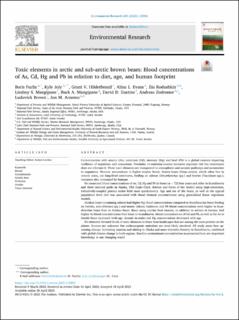| dc.contributor.author | Fuchs, Boris | |
| dc.contributor.author | Joly, Kyle | |
| dc.contributor.author | Hilderbrand, Grant V. | |
| dc.contributor.author | Evans, Alina | |
| dc.contributor.author | Rodushkin, Ilia | |
| dc.contributor.author | Mangipane, Lindsey S. | |
| dc.contributor.author | Mangipane, Buck A. | |
| dc.contributor.author | Gustine, David D. | |
| dc.contributor.author | Zedrosser, Andreas | |
| dc.contributor.author | Brown, Ludovick | |
| dc.contributor.author | Arnemo, Jon Martin | |
| dc.date.accessioned | 2023-10-05T08:42:59Z | |
| dc.date.available | 2023-10-05T08:42:59Z | |
| dc.date.created | 2023-05-11T13:08:12Z | |
| dc.date.issued | 2023 | |
| dc.identifier.citation | Fuchs, B., Joly, K., Hilderbrand, G. V., Evans, A. L., Rodushkin, I., Mangipane, L. S., Mangipane, B. A., Gustine, D. D., Zedrosser, A., Brown, L. & Arnemo, J. M. (2023). Toxic elements in arctic and sub-arctic brown bears: Blood concentrations of As, Cd, Hg and Pb in relation to diet, age, and human footprint. Environmental Research, 229, Artikkel 115952. | en_US |
| dc.identifier.issn | 0013-9351 | |
| dc.identifier.uri | https://hdl.handle.net/11250/3094387 | |
| dc.description.abstract | Contamination with arsenic (As), cadmium (Cd), mercury (Hg) and lead (Pb) is a global concern impairing resilience of organisms and ecosystems. Proximity to emission sources increases exposure risk but remoteness does not alleviate it. These toxic elements are transported in atmospheric and oceanic pathways and accumulate in organisms. Mercury accumulates in higher trophic levels. Brown bears (Ursus arctos), which often live in remote areas, are long-lived omnivores, feeding on salmon (Oncorhynchus spp.) and berries (Vaccinium spp.), resources also consumed by humans.
We measured blood concentrations of As, Cd, Hg and Pb in bears (n = 72) four years and older in Scandinavia and three national parks in Alaska, USA (Lake Clark, Katmai and Gates of the Arctic) using high-resolution, inductively-coupled plasma sector field mass spectrometry. Age and sex of the bears, as well as the typical population level diet was associated with blood element concentrations using generalized linear regression models.
Alaskan bears consuming salmon had higher Hg blood concentrations compared to Scandinavian bears feeding on berries, ants (Formica spp.) and moose (Alces). Cadmium and Pb blood concentrations were higher in Scandinavian bears than in Alaskan bears. Bears using marine food sources, in addition to salmon in Katmai, had higher As blood concentrations than bears in Scandinavia. Blood concentrations of Cd and Pb, as well as for As in female bears increased with age. Arsenic in males and Hg concentrations decreased with age.
We detected elevated levels of toxic elements in bears from landscapes that are among the most pristine on the planet. Sources are unknown but anthropogenic emissions are most likely involved. All study areas face upcoming change: Increasing tourism and mining in Alaska and more intensive forestry in Scandinavia, combined with global climate change in both regions. Baseline contaminant concentrations as presented here are important knowledge in our changing world. | en_US |
| dc.language.iso | eng | en_US |
| dc.rights | Navngivelse 4.0 Internasjonal | * |
| dc.rights.uri | http://creativecommons.org/licenses/by/4.0/deed.no | * |
| dc.title | Toxic elements in arctic and sub-arctic brown bears: Blood concentrations of As, Cd, Hg and Pb in relation to diet, age, and human footprint | en_US |
| dc.type | Peer reviewed | en_US |
| dc.type | Journal article | en_US |
| dc.description.version | publishedVersion | en_US |
| dc.rights.holder | © 2023 The Authors. | en_US |
| dc.source.volume | 229 | en_US |
| dc.source.journal | Environmental Research | en_US |
| dc.identifier.doi | https://doi.org/10.1016/j.envres.2023.115952 | |
| dc.identifier.cristin | 2146943 | |
| dc.source.articlenumber | 115952 | en_US |
| cristin.ispublished | true | |
| cristin.fulltext | original | |
| cristin.qualitycode | 2 | |

